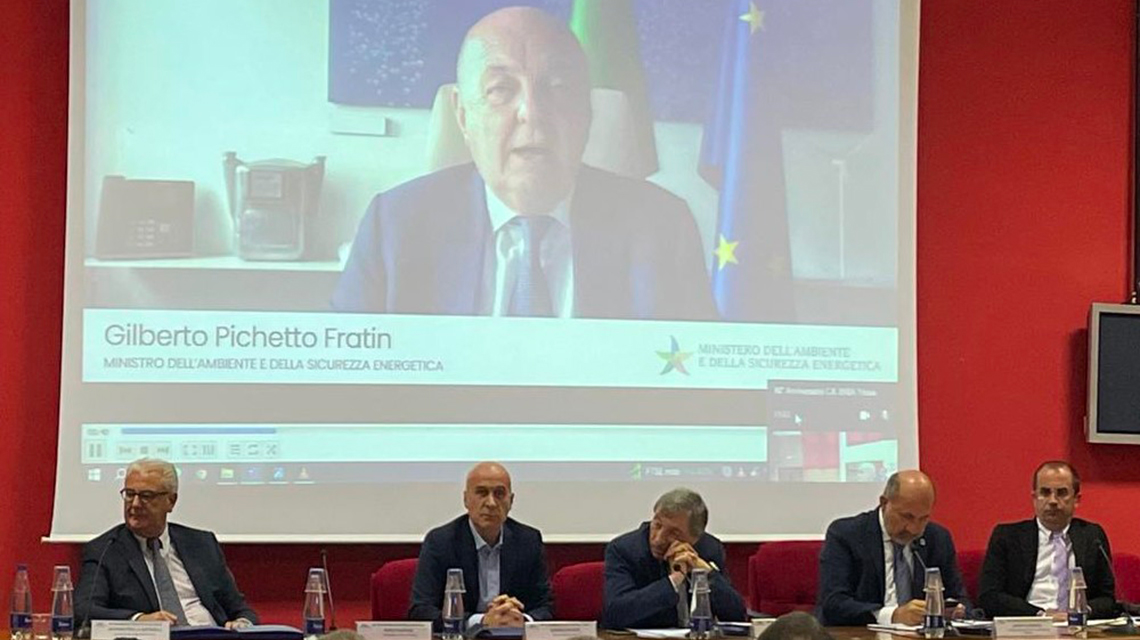Italian National Agency for New Technologies, Energy and Sustainable Economic Development

Energy: "Biolube", ENEA new research platform on green chemistry
Presented on the occasion of the 60 years of the ENEA Trisaia Center (Matera) attended by ministers Pichetto and Fitto
"Biolube" is an innovative platform created by ENEA in the Trisaia Research Center (Matera) to produce advanced bio-lubricants and biofuels, intended to boost decarbonisation in various sectors, including air transport. The presentation of the infrastructure took place on the occasion of the celebrations for the 60 years of the ENEA Trisaia Centre and was attended by the Minister of the Environment and Energy Security Gilberto Pichetto Fratin and the Minister of European Affairs, cohesion and PNRR Raffaele Fitto with a video message, ENEA president Gilberto Dialuce and ENEA general director Giorgio Graditi, the Assessor for the Environment and Energy of the Basilicata Region Cosimo Latronico, the president of the Matera Province Piero Marrese and the mayor of Rotondella (where the Trisaia Center is located) Gianluca Palazzo.
“60 years since its foundation, the ENEA Trisaia Research Center proves to be a well-established key scientific resource in Southern Italy. With 15 laboratories, as many pilot plants and 8 cutting-edge technological halls, the Center conducts numerous research and development activities, promoting strategic collaborations with institutions, research bodies and companies", said ENEA president Gilberto Dialuce. “However, this center of excellence extends beyond its geographical boundaries and contributes significantly to scientific progress at both a national and international level,” continued Dialuce.
“We celebrated the 60 years of the ENEA Trisaia Research Center strengthening its role as a technological hub of reference for Basilicata and the whole of Southern Italy, by presenting a new research facility on green chemistry, unique in the Italian panorama and among the most innovative in Europe”, pointed out ENEA general director Giorgio Graditi.
Co-funded by the Basilicata Region, the “Biolube” platform converts vegetable oils through oligomerization, thin film evaporation, hydrogenation and distillation processes. “The oligomerization unit uses a 300 liter reactor heated with diathermic oil to synthesize macromolecules,” explained Pietro Garzone, coordinator of the ENEA group for the design and experimental operation of the infrastructure.
“Biolube will provide a significant contribution to achieving a decarbonised economy, enabling us to strenghten the research and development activities of our Bioenergy, Biorefineries and Green Chemistry Division in the sector of biofuels and advanced biolubricants produced from vegetable oils, including those from separate waste collection”, said Graditi.
The activities carried out will allow to assess engineering and process risks and produce significant quantities of biolubricants. “Furthermore, in the coming months we will start a collaboration with one of the most important national players in the field of chemistry, aimed at demonstrating a biolubricant synthesis process”, concluded Graditi.
“The transition to a sustainable economy will require major shifts in technology, industry, the economy and society as a whole,” said the Minister of Environment and Energy Security Gilberto Pichetto Fratin. “Basilicata – he went on – is one of the territories in which the energy field, with its undoubted complexities, was and still is one of the main economic development sectors. The ENEA Trisaia Research Center is a major multidisciplinary scientific hub: its technological expertise is recognized as of significant national interest and can count on a project portfolio of great importance".
“The celebration was an opportunity to draw a line of demarcation, verify what has been done and look at the future” said Minister Fitto “. “The Centre has been capable to seize investment opportunities and European resources, but above all it has been able to adapt to new scenarios. The work done so far - he added - is very important but so is the work to be be done in reference to the new challenges and new objectives that await us, for instance the PNRR and Repower EU, and I believe that in the future the Trisaia center will play a considerable and significant role".
The ENEA Trisaia Research Center, established in 1964, was created to study the reprocessing of spent nuclear fuel; after the 1987 referendum it was converted into a multi-interdisciplinary research center thanks to EU funds and a 56 million euro integrated plan which established four main research areas: agrobiotechnology, environmental protection, innovative materials, biomass energy and thermodynamic solar. In 2004, the Center obtained the dual certification of the Integrated Management System for the Environment[1] and Safety[2], and in 2007 it obtained the EMAS registration, based on the continuous improvement of environmental and safety performance.
From 2013 to 2023, the Center dedicated its activities to energy, sustainable economic development, agro-industry and new technologies, particularly biomass, biofuels, solar thermal, biotechnology, waste and wastewater treatment, materials technology and metrology. The Center, which has 120 employees and hosts research fellows, thesis and scholarship holders, will undergo an organizational restructuring aimed at positioning itself at an high national and international level for development activities on cutting-edge plants and infrastructures.
